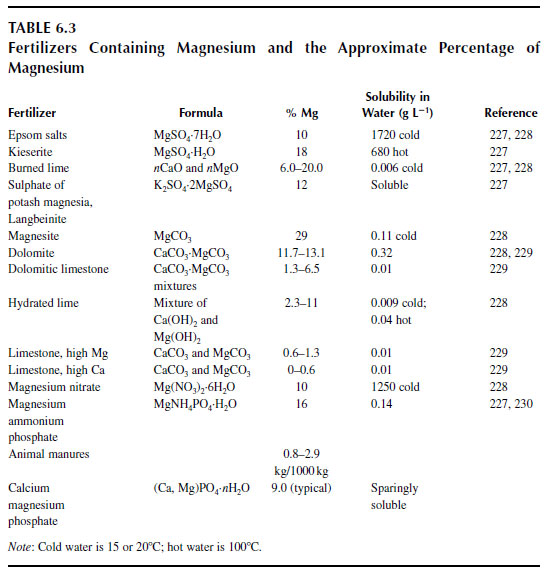Effects of Fertilizers on Plant Growth
Although the requirements for magnesium is low relative to other macronutrients such as nitrogen (222), the effect of magnesium fertilization on plant growth may vary with the form of magnesium used and the fertilizer texture (coarseness) (223). Therefore, the type of magnesium fertilizer to use will depend on variables such as the type of crop and the longevity of the production cycle. In studies with ryegrass (Lolium perenne L.), the highest magnesium uptake occurred from fertilizers as follows: magnesium sulfate > potassium magnesium sulfate (K2SO4.2MgSO4) > ground dolomite > pelletized dolomite (224). Studies by Tayrien and Whitcomb (119,120,225) indicated that the use of calcium carbonate and magnesium oxide produced greater vegetative growth than equivalent quantities of calcium and magnesium supplied with dolomitic limestone (calcium carbonate and magnesium carbonate intergrade). However, in studies with cotoneaster (Cotoneaster dammeri C.K. Schneid), the greatest vegetative growth of roots and shoots occurred with the use of dolomite rather than with combinations of other calcium and magnesium sources (109). |
In other experiments with containerized woody ornamentals, the use of calcium and magnesium sulfates resulted in equal or better quality plants than plants receiving the same amount of calcium and magnesium in the carbonate form, regardless of the grade of dolomite (223). The effects of powdered dolomite compared to pelletized dolomite on plant quality varied with the rate of dolomite application, plant type, and form of other nutrients used, but there tended to be a general trend of increased plant quality with powdered dolomite compared to pelletized dolomite at low fertilizer rates (2.97 kg dolomite m-3), but higher plant quality with pelletized compared to powdered dolomite at higher fertilization rates (5.95 kg dolomite m-3). The diversity of growth effects with different fertilizer types can be attributed to the different solubilities of magnesium compounds and the coarseness of the fertilizers. The more soluble and finer the particle size of the fertilizers are, the more quickly they will dissolve and be available for plant uptake, but also the more quickly magnesium will leach from the root zone. Therefore, although quickly soluble fertilizer forms are suitable for relatively short-term crops (a few weeks), they would not be suitable for long-term crops since fertilizer might not be available in the later stages of crop development.




